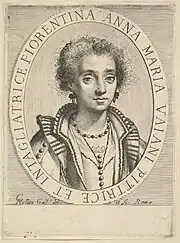Anna Maria Vaiana
Anna Maria Vaiana oder Vaiani (* ca. 1610 in Florenz; † um 1660 in Rom),[1] war eine italienische Malerin des Barock.

Sie war die Tochter des florentinischen Malers Alessandro Vaiani, der in den 1620er Jahren mit seiner Familie nach Rom zog. Die heute fast vergessene Anna Maria Vaiana war eine der bekanntesten weiblichen Künstlerinnen Roms und gehörte zusammen mit Virginia da Vezzo, Artemisia Gentileschi und Maddalena Corvini zu den Malerinnen, von denen der Kupferstecher Claude Mellan ein Porträt veröffentlichte, auf dem die Vaiana als „Malerin und Schnitzerin“ (Pittrice e Intagliatrice) bezeichnet wird.[2] In den 1630er Jahren[1] und im Jahr 1655 war sie in der römischen Malergilde, der Accademia di San Luca, registriert.[3]
Anna Maria Vaiana war vor allem als Blumenmalerin und -zeichnerin bekannt und zählte zu ihren Mäzenen den Gelehrten Cassiano del Pozzo.[2] Von 1630 bis 1638 stand sie in Briefkontakt mit Galileo Galilei,[4] der für sie einige Empfehlungsschreiben an Fürst Taddeo Barberini und an den Kardinal Francesco Barberini schrieb. So gehörte sie bald zum künstlerischen Umfeld des einflussreichen Barberini-Hofes.[3]
Laut einem Inventar von 1631 malte sie für die Barberini eine Madonna mit Kind und dem hl. Johannes d. Täufer, als Kopie nach Tizian; das Bild war als Geschenk für Papst Urban VIII. bestimmt.[5]
1632 steuerte sie neben anderen Künstlern wie Mario Nuzzi einige Zeichnungen als Illustration für das berühmte botanische Werk De Florum Cultura von Giovan Battista Ferrari bei, das unter der Schirmherrschaft des Kardinals Francesco 1633 veröffentlicht wurde.[3]
Die Vaiana vollendete außerdem eine von ihrem Vater begonnene Freskendekoration in der Kapelle Papst Urbans VIII. im Apostolischen Palast des Vatikan, wofür sie eine Bezahlung von 348 Scudi erhielt.[3]
1647 heiratete sie den französischen Maler Guillaume Courtois. Doch die Ehe ging sehr schnell schief und ihr Mann hielt sie gegen ihren Willen unter Hausarrest wie eine Gefangene. Sie konnte jedoch entkommen und es gelang ihr sogar, die Scheidung durchzusetzen und ihre Mitgift zurückzubekommen. Die Scheidungsurkunde wurde von Domenico di Guido Vaiani unterzeichnet, dem Vize-Kastellan von Castel Sant’Angelo und einem angesehenen Mitglied des Barberini-Kreises.[6]
1654 stiftete sie für die Kirche der Accademia di San Luca sogenannte luoghi di monte, das waren „langfristige Anleihen und die häufigste Form der Geldanlage für Künstler“, die mit 5 Prozent pro Jahr verzinst wurden und „leicht verkauft oder vererbt werden konnten“.[7]
Ihr Sterbedatum ist bisher nicht bekannt.
Literatur
- Maria Barbara Guerrieri Borsoi: Novità su Alessandro e Anna Maria Vaiani. In: Bollettino dei Musei Vaticani. Band 27, 2009, S. 241–264.
- Pietro Greco: Galileo Galilei, the tuscan artist. Springer, 2018, S. 350.
- Consuelo Lollobrigida: Baroque women’s artistic position in the age of the Barberini. In: Pietro di Loreto (Hrsg.): L'Archivio di Caravaggio. Scritti in onore di don Sandro Corradini, 2021. Etgraphiae / Cartograph, Foligno, 2021, S. 175–190. Auf Academia.edu (Online, italienisch), abgerufen am 6. März 2022.
Weblinks
- Vaiani, Anna Maria, in: Worldcat Identities (Abruf am 17. Februar 2022)
Einzelnachweise
- S. 183 in: Consuelo Lollobrigida: Baroque women’s artistic position in the age of the Barberini, in: Pietro di Loreto (Hrg.): L'Archivio di Caravaggio. Scritti in onore di don Sandro Corradini, 2021, Etgraphiae / Cartograph, Foligno, 2021, S. 175–190 (online als PDF; Abruf am 17. Februar 2022)
- S. 178 in: Consuelo Lollobrigida: Baroque women’s artistic position in the age of the Barberini, in: Pietro di Loreto (Hrg.): L'Archivio di Caravaggio. Scritti in onore di don Sandro Corradini, 2021, Etgraphiae / Cartograph, Foligno, 2021, S. 175–190 (online als PDF; Abruf am 17. Februar 2022)
- S. 184 in: Consuelo Lollobrigida: Baroque women’s artistic position in the age of the Barberini, in: Pietro di Loreto (Hrg.): L'Archivio di Caravaggio. Scritti in onore di don Sandro Corradini, 2021, Etgraphiae / Cartograph, Foligno, 2021, S. 175–190 (online als PDF; Abruf am 17. Februar 2022)
- Pietro Greco: Galileo Galilei, the tuscan artist, Springer, 2018, S. 350
- Der Text im Inventar des Kardinals Francesco Barberini (III. Inv. 26–31; in: Aronberg Lavin, 1975), 6. September 1631, lautet: „…un Quadro con la Mad.na e N.S. in Braccio con San Giovannino con lo splendore e’torno pieno di Cherubini alto p.mi 5 largo p.mi 4 copiata dalla figliola del Vaiana; dalla med.ma di Titiano che dono N.S. Papa Urbano VIII“. Siehe S. 183 (und Fußnote), in: Consuelo Lollobrigida: Baroque women’s artistic position in the age of the Barberini, in: Pietro di Loreto (Hrg.): L'Archivio di Caravaggio. Scritti in onore di don Sandro Corradini, 2021, Etgraphiae / Cartograph, Foligno, 2021, S. 175–190 (online als PDF; Abruf am 17. Februar 2022)
- S. 176 und Fußnote 4, in: Consuelo Lollobrigida: Baroque women’s artistic position in the age of the Barberini, in: Pietro di Loreto (Hrg.): L'Archivio di Caravaggio. Scritti in onore di don Sandro Corradini, 2021, Etgraphiae / Cartograph, Foligno, 2021, S. 175–190 (online als PDF; Abruf am 17. Februar 2022)
- “The „luoghi di monte“ were long-term bonds and the most common way the artists had to invest their finance. The shares paid 5 percent per annum. As liquid instruments they could be easily sold or left as bequests”. Siehe: S. 186 und Fußnote 38, in: Consuelo Lollobrigida: Baroque women’s artistic position in the age of the Barberini, in: Pietro di Loreto (Hrg.): L'Archivio di Caravaggio. Scritti in onore di don Sandro Corradini, 2021, Etgraphiae / Cartograph, Foligno, 2021, S. 175–190 (online als PDF; Abruf am 17. Februar 2022)